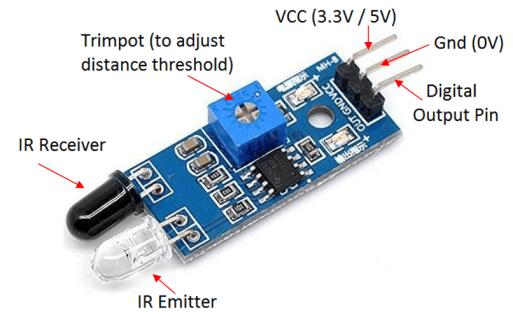
Infrared sensors, as a crucial component widely used in the global electronic components industry, play a key role in various fields due to their sensitivity to infrared radiation (i.e., heat). In this article, we will delve into the definition, working principle, types, characteristics, and advantages of infrared sensors.
Catalog
IV. Characteristics and Advantages
I. What Are Infrared Sensors?
An infrared (IR) sensor is an electronic device that measures and detects infrared radiation in its surrounding environment. Infrared radiation, discovered by astronomer William Herschel in 1800, is invisible to the human eye because its wavelength is longer than visible light, although it falls within the same electromagnetic spectrum. Anything that emits heat (objects with a temperature above approximately five degrees Kelvin) produces infrared radiation. IR sensors convert detected infrared signals into electrical signals, providing valuable data for analysis and control.

II. Working Principle
Infrared sensors operate by working with infrared radiation and can be active or passive (PIR).
Active infrared sensors work with radar technology, emitting and receiving infrared radiation. The radiation hits nearby objects and bounces back to the device's receiver, allowing the sensor to detect movement and measure the distance of objects from the device. This technology is particularly useful in robotics for proximity detection.
In contrast, passive infrared (PIR) sensors are more commonly used in physical security applications. PIR sensors do not emit radiation but rather receive it from nearby objects. These sensors trigger an alarm when there is an anomaly in the infrared waves measured in a room, such as when a warm object (like an intruder) crosses the sensor's signal.
III. Types
There are two primary types of infrared sensors: active and passive.
Active infrared sensors emit and detect infrared radiation. They consist of a light-emitting diode (LED) and a receiver. When an object approaches the sensor, the infrared light from the LED reflects off the object and is detected by the receiver. Active IR sensors act as proximity sensors and are frequently used in obstacle detection systems.
Passive infrared (PIR) sensors, on the other hand, only detect infrared radiation and do not emit it. They consist of:
· Two strips of pyroelectric material (a pyroelectric sensor)
· An infrared filter (to block out other wavelengths of light)
· A Fresnel lens (to collect light from various angles into a single point)
· A housing unit (to protect the sensor from environmental factors like humidity)
PIR sensors are most commonly used in motion-based detection. When a moving object that emits infrared radiation enters the sensor's range, the difference in IR levels between the two pyroelectric elements is measured. The sensor then sends an electronic signal to an embedded computer, which triggers an alarm.
IV. Characteristics and Advantages
Infrared sensors stand out in the electronic components industry due to their following characteristics and advantages:
· High Sensitivity: Infrared sensors are highly sensitive to changes in heat and can precisely measure temperature and other parameters.
· Non-Contact Measurement: Sensors can measure without direct contact with the target object, improving the safety and efficiency of measurements.
· Versatility: Infrared sensors can measure multiple parameters such as temperature, motion, and distance, making them suitable for a wide range of applications.
· Fast Response: The sensors can respond quickly to infrared signals, enabling real-time measurement and control.
V. Applications
Infrared sensors play a critical role in various fields, with applications in the electronic components industry including:
· Automation and Control Systems: Infrared sensors detect movement and heat sources in the environment, enabling automated doors, lighting control, and indoor temperature regulation for convenience and energy efficiency.
· Security Systems: By detecting changes in heat sources, infrared sensors can accurately identify intruders and activate alarm systems, enhancing the reliability of security measures.
· Medical Devices: Infrared sensors provide quick and accurate patient temperature measurement and monitoring of vital signs, reducing infection risks and improving diagnostic efficiency.
· Automotive Sector: Infrared sensors improve driving safety in night vision systems and driver monitoring by detecting fatigue and distraction.
· Consumer Electronics: In smartphones, infrared sensors enable facial recognition and temperature monitoring features, ensuring the security and stability of user devices.
VI. Conclusion
In conclusion, infrared sensors play an indispensable role in the electronic components industry. Their high sensitivity, non-contact measurement, versatility, and rapid response capabilities give them vast potential for future development. As technology continues to advance, infrared sensors will expand their applications across various fields, bringing greater convenience and safety to human life.




